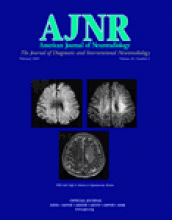Research ArticleBrain
Cerebral Hyperperfusion Following Carotid Endarterectomy: Diagnostic Utility of Intraoperative Transcranial Doppler Ultrasonography Compared with Single-Photon Emission Computed Tomography Study
Kuniaki Ogasawara, Takashi Inoue, Masakazu Kobayashi, Hidehoko Endo, Kenji Yoshida, Takeshi Fukuda, Kazunori Terasaki and Akira Ogawa
American Journal of Neuroradiology February 2005, 26 (2) 252-257;
Kuniaki Ogasawara
Takashi Inoue
Masakazu Kobayashi
Hidehoko Endo
Kenji Yoshida
Takeshi Fukuda
Kazunori Terasaki

References
- ↵Piepgras DG, Morgan MK, Sundt TM Jr., Yanagihara T, Mussman LM. Intracerebral hemorrhage after carotid endarterectomy. J Neurosurg 1988;68:532–536
- ↵Sundt TM Jr., Sharbrough FW, Piepgras DG, Kearns TP, Messick JM Jr., O’Fallon WM. Correlation of cerebral blood flow and electroencephalographic changes during carotid endarterectomy, with results of surgery and hemodynamics of cerebral ischemia. Mayo Clin Proc 1981;56:533–543
- ↵Solomon RA, Loftus CM, Quest DO, Correll JW. Incidence and etiology of intracerebral hemorrhage following carotid endarterectomy. J Neurosurg 1986;64:29–34
- Jansen C, Sprengers AM, Moll FL, et al. Prediction of intracerebral haemorrhage after carotid endarterectomy by clinical criteria and intraoperative transcranial Doppler monitoring: results of 233 operations. Eur J Vasc Surg 1994;8:220–225
- Ouriel K, Shortell CK, Illig KA, Greenberg RK, Green RM. Intracerebral hemorrhage after carotid endarterectomy: Incidence, contribution to neurologic morbidity, and predictive factors. J Vasc Surg 1999;29:82–89
- Pomposelli FB, Lamparello PJ, Riles TS, Craighead CC, Giangola G, Imparato AM. Intracranial hemorrhage after carotid endarterectomy. J Vasc Surg 1988;7:248–255
- Riles TS, Imparato AM, Jacobowitz GR, et al. The cause of perioperative stroke after carotid endarterectomy. J Vasc Surg 1994;19:206–216
- ↵
- ↵Dalman JE, Beenakkers IC, Moll FL, Leusink JA, Ackerstaff RG. Transcranial Doppler monitoring during carotid endarterectomy helps to identify patients at risk of postoperative hyperperfusion. Eur J Vasc Endovasc Surg 1999;18:222–227
- Mansoor GA, White WB, Grunnet M, Ruby ST. Intracerebral hemorrhage after carotid endarterectomy associated with ipsilateral fibrinoid necrosis: a consequence of the hyperperfusion syndrome? J Vasc Surg 1996;23:147–151
- Reigel MM, Hollier LH, Sundt TM Jr., Piepgras DG, Sharbrough FW, Cherry KJ. Cerebral hyperperfusion syndrome: a cause of neurologic dysfunction after carotid endarterectomy. J Vasc Surg 1987;5:628–634
- ↵Yoshimoto T, Houkin K, Kuroda S, Abe H, Kashiwaba T. Low cerebral blood flow and perfusion reserve induce hyperperfusion after surgical revascularization: case reports and analysis of cerebral hemodynamics. Surg Neurol 1997;48:132–139
- ↵Spencer MP. Transcranial Doppler monitoring and causes of stroke from carotid endarterectomy. Stroke 1997;28:685–691
- ↵Keunen R, Nijmeijer HW, Tavy D, et al. An observational study of pre-operative transcranial Doppler examinations to predict cerebral hyperperfusion following carotid endarterectomies. Neurol Res 2001;23:593–598
- ↵North American Symptomatic Carotid Endarterectomy Trial Collaborators. Beneficial effect of carotid endarterectomy in symptomatic patients with high-grade carotid stenosis. N Engl J Med 1991;325:445–453
- ↵Iida H, Itoh H, Nakazawa M, et al. Quantitative mapping of regional cerebral blood flow using iodine-123-IMP and SPECT. J Nucl Med 1994;35:2019–2030
- ↵Ogasawara K, Ito H, Sasoh M, et al. Quantitative measurement of regional cerebrovascular reactivity to acetazolamide using 123I-N-isopropyl-p-iodoamphetamine autoradiography with SPECT: validation study using H2 15O with PET. J Nucl Med 2003;44:520–525
- ↵Kretschmann HJ, Weinrich W. Neuroanatomy and cranial computed tomography. New York: Thieme Inc;1986;70–74
- ↵Hosoda K, Kawaguchi T, Shibata Y, et al. Cerebral vasoreactivity and internal carotid artery flow help to identify patients at risk for hyperperfusion after carotid endarterectomy. Stroke 2001;32:1567–1573
- ↵Ogasawara K, Konno H, Yukawa H, Endo H, Inoue T, Ogawa A. Transcranial regional cerebral oxygen saturation monitoring during carotid endarterectomy as a predictor of postoperative hyperperfusion. Neurosurgery 2003;53:309–314
- ↵Ogasawara K, Yukawa H, Kobayashi M, et al. Prediction and monitoring of cerebral hyperperfusion after carotid endarterectomy by using single-photon emission computerized tomography scanning. J Neurosurg 2003;99:504–510
- ↵Pindzola RR, Balzer JR, Nemoto EM, Goldstein S, Yonas H. Cerebrovascular reserve in patients with carotid occlusive disease assessed by stable xenon-enhanced CT cerebral blood flow and transcranial Doppler. Stroke 2001;32:1811–1817
- ↵Schaafsma A, Veen L, Vos JP. Three cases of hyperperfusion syndrome identified by daily transcranial Doppler investigation after carotid surgery. Eur J Vasc Endovasc Surg 2002;23:17–22
- ↵Levi CR, O’Malley HM, Fell G, et al. Transcranial Doppler detected cerebral microembolism following carotid endarterectomy: High microembolic signal loads predict postoperative cerebral ischaemia. Brain 1997;120:621–629
- ↵Vernieri F, Pasqualetti P, Passarelli F, Rossini PM, Silvestrini M. Outcome of carotid artery occlusion is predicted by cerebrovascular reactivity. Stroke 1999;30:593–598
In this issue
Advertisement
Kuniaki Ogasawara, Takashi Inoue, Masakazu Kobayashi, Hidehoko Endo, Kenji Yoshida, Takeshi Fukuda, Kazunori Terasaki, Akira Ogawa
Cerebral Hyperperfusion Following Carotid Endarterectomy: Diagnostic Utility of Intraoperative Transcranial Doppler Ultrasonography Compared with Single-Photon Emission Computed Tomography Study
American Journal of Neuroradiology Feb 2005, 26 (2) 252-257;
0 Responses
Cerebral Hyperperfusion Following Carotid Endarterectomy: Diagnostic Utility of Intraoperative Transcranial Doppler Ultrasonography Compared with Single-Photon Emission Computed Tomography Study
Kuniaki Ogasawara, Takashi Inoue, Masakazu Kobayashi, Hidehoko Endo, Kenji Yoshida, Takeshi Fukuda, Kazunori Terasaki, Akira Ogawa
American Journal of Neuroradiology Feb 2005, 26 (2) 252-257;
Jump to section
Related Articles
- No related articles found.
Cited By...
- Sentinel Angiographic Signs of Cerebral Hyperperfusion after Angioplasty and Stenting of Intracranial Atherosclerotic Stenosis: A Technical Note
- Staged carotid artery angioplasty and stenting for patients with high-grade carotid stenosis with high risk of developing hyperperfusion injury: a retrospective analysis of 44 cases
- Computed tomographic perfusion imaging of non-hemorrhagic cerebral hyperperfusion syndrome and reversal following medical treatment after carotid artery angioplasty and stenting
- Has Free Radical Release Across the Brain After Carotid Endarterectomy Traditionally Been Underestimated?: Significance of Reperfusion Hemodynamics
This article has not yet been cited by articles in journals that are participating in Crossref Cited-by Linking.
More in this TOC Section
Similar Articles
Advertisement











